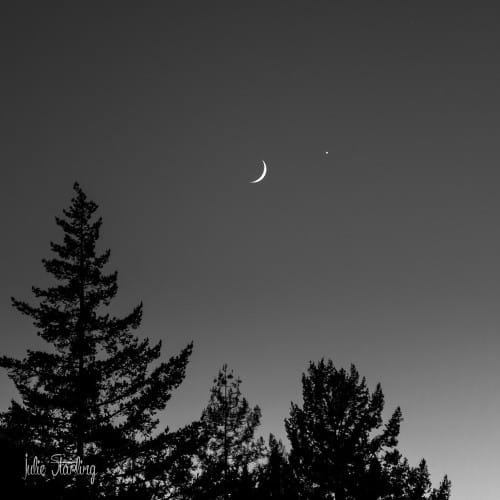A few weeks ago, Venus and Jupiter were very close to each other and photographers all over were shooting the two planets next to the moon. I wasn't shooting then. I didn't have the right equipment I'd need to get the shot I would want, plus I wasn't so well. But we sat outside on the terrace and enjoyed the viewing.
"The bright one is Jupiter," said Mr. Wild Dingo.
"No it's not. It's Venus, " I replied.
And so the argument went. He argued for Jupiter because it was bigger and made up of gas and I argued for Venus because it was closer. He took out his star gazing map on the Ipad. It confirmed the location of Venus and it being the brighter planet.
"This is wrong," he claimed, holding onto his conviction. He went on to research on the Internet which planet was which until he finally conceded that the brighter planet was Venus.
Poor Mr. Wild Dingo! It's not easy losing an argument to a chick with Lyme brain.
So being the hero, he climbed up the winder stairs in our house to the attic and dragged out our bitchin' telescope out to the rooftop widows walk. We both got to view both planets and even four of Jupiter's moons! That was really spectacular. It made me wish I had a tripod with a 500 mm lens!
But here's something I did NOT know: Jupiter has 67 confirmed moons! From Wikipedia:
The most massive of them, the four Galilean moons, were discovered in 1610 by Galileo Galilei and were the first objects found to orbit a body that was neither Earth nor the Sun. From the end of the 19th century, dozens of much smaller Jovian moons have been discovered and have received the names of lovers, conquests, or daughters of the Roman god Jupiter, or his Greek equivalent, Zeus. The Galilean moons are by far the largest and most massive objects in orbit around Jupiter, with the remaining 63 moons and the rings together comprising just 0.003% of the total orbiting mass.
I guess what we saw were the four Galilean moons.

So beautiful...
That is so cool!! I wish we had a telescope. So awesome!